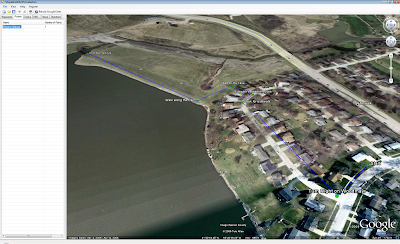The Google Earth plugin is offering many new opportunities for writing custom web-based and desktop applications. iEarth is an experiment that uses Google Earth as the map for interacting with GPS and GIS data.
The Google Earth plugin is intended for use in a web page, but can also be embedded in a desktop application in a web control or referenced as an ActiveX control.
A common method for embedding the Google Earth plugin in a desktop application can be viewed online as a part of the
Google Earth code samples.
Part of what makes the Google Earth plugin so much more flexible than its desktop counterpart is the programmatic control that is given to developers through its API.
Not only can spatial data be loaded as KML, but the source data can be directly manipulated through the Google Earth interface.
An example of this is the GPX editor seen below.
GPX is an XML based exchange format for GPS data such as waypoints, routes, and tracks. The GPX editor in iEarth can load existing GPX data for viewing or editing, and also lets users digitize and edit data from scratch. The data is translated into KML for viewing in Google Earth, but is kept in internally in the GPX format for saving.
This same method can be used with Shapefiles. The next release of
Shape2Earth will embed a link to the shapefile so that editing spatial or attribute data in iEarth will also edit the shapefile.
 Google Earth Plugin in iEarth
Google Earth Plugin in iEarth Digitize a GPX Waypoint and enter data
Digitize a GPX Waypoint and enter data View the GPX attributes in the Google Earth Balloon
View the GPX attributes in the Google Earth Balloon
 Digitize Routes in Google Earth and save as GPX for use in GPS Receivers
Digitize Routes in Google Earth and save as GPX for use in GPS Receivers
 Right click on existing data to edit the attribute data
Right click on existing data to edit the attribute data





